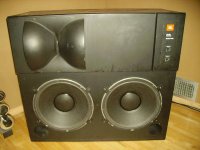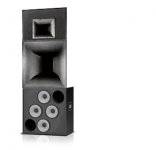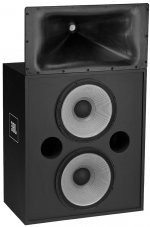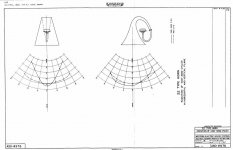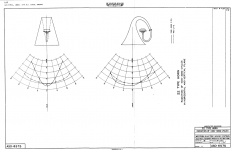I've heard all the hyperbole before, applied to a lot of systems from a lot of eras. Lets just consider the logic of situation. A group of engineers in the 1920's develop some seemingly conventional looking speakers. I see a long exponental horn coiled into a circle and a bit. Initial models are run full range and so have no benefit of crossover networks to help shape the sound. Early technology compression drivers look conventional but are superior to anything from the era or even much later, perhaps its the magic of the field coils.
In spite of Shearer or Hilliard's dissatisfaction the units have mythical qualities. In spite of the cinema industry overlooking them and rushing on to the "next big thing", they were better than everything else and nobody knew it at the time.
No ones engineering could compare. Decades later they were still superior to the best that Jensen, Altec or Bozak could offer. (Systems we all acknowledge as flawed.) Nobody really new how to design crossovers in the 50's (they didn't), but the Western Electric engineers did in the 20's.
Sorry if I remain sceptical.
Starker and Oistrakh probably do sound great. Solo violin can be quite stunning, even enhanced, on a fairly narrow band system. Read up about all the live vs. recorded demonstrations that have been conducted over the decades. When a soprano stood next to an Edison Diamond Disk gramophone and sang, nobody could hear the difference. No progress since then?
Coloration is a fairly standard term, probably starting with the Brits. It refers to any frequency response error that gives a personality or character to a system. You might get used to them but they are still flaws. The problem with these response errors is that they are everpresent. No matter what instrument, or what performer is playing, the sound of the speaker is adding its personality, intruding into the performance. This is the area where the most progress has been made over the decades, in the continuos reduction of the level of colorations.
A lot of people who enjoy vintage systems have developed an ability to listen through the faults and savor the good qualities. No problem with that, different strokes for different folks. Lets just not deny that the faults are there.
People make similar arguements about old camera lenses. Certain models have a "roundness" or a "glow". Measurements show a high level of the classic lens abberations, but the lovers of the look cry "foul", "measurements mean nothing". If you have the systems, send me some measurements. Maybe that would reveal the magic of Western Electric.
David S.
In spite of Shearer or Hilliard's dissatisfaction the units have mythical qualities. In spite of the cinema industry overlooking them and rushing on to the "next big thing", they were better than everything else and nobody knew it at the time.
No ones engineering could compare. Decades later they were still superior to the best that Jensen, Altec or Bozak could offer. (Systems we all acknowledge as flawed.) Nobody really new how to design crossovers in the 50's (they didn't), but the Western Electric engineers did in the 20's.
Sorry if I remain sceptical.
Starker and Oistrakh probably do sound great. Solo violin can be quite stunning, even enhanced, on a fairly narrow band system. Read up about all the live vs. recorded demonstrations that have been conducted over the decades. When a soprano stood next to an Edison Diamond Disk gramophone and sang, nobody could hear the difference. No progress since then?
Coloration is a fairly standard term, probably starting with the Brits. It refers to any frequency response error that gives a personality or character to a system. You might get used to them but they are still flaws. The problem with these response errors is that they are everpresent. No matter what instrument, or what performer is playing, the sound of the speaker is adding its personality, intruding into the performance. This is the area where the most progress has been made over the decades, in the continuos reduction of the level of colorations.
A lot of people who enjoy vintage systems have developed an ability to listen through the faults and savor the good qualities. No problem with that, different strokes for different folks. Lets just not deny that the faults are there.
People make similar arguements about old camera lenses. Certain models have a "roundness" or a "glow". Measurements show a high level of the classic lens abberations, but the lovers of the look cry "foul", "measurements mean nothing". If you have the systems, send me some measurements. Maybe that would reveal the magic of Western Electric.
David S.
old, new, borrowed, blue
I believe the best current work marries the genius of the elders, who were young when they did their best work, with what has come after. So we have for instance the LAB 12 horn, which to my amateur eye marries an AR 1 driver to a bass horn. Diversity generates the best and worst outcomes, or as I like to say, welcome to history. Thanks Speakerdave for moderating this conversation, since I'm partial to the oldtimers, being a junior senior (66) myself. This is akin to asking whether the carbon fiber cellos are worth listening to. Singer? Song?
I believe the best current work marries the genius of the elders, who were young when they did their best work, with what has come after. So we have for instance the LAB 12 horn, which to my amateur eye marries an AR 1 driver to a bass horn. Diversity generates the best and worst outcomes, or as I like to say, welcome to history. Thanks Speakerdave for moderating this conversation, since I'm partial to the oldtimers, being a junior senior (66) myself. This is akin to asking whether the carbon fiber cellos are worth listening to. Singer? Song?
Thanks Joe for the great photos and text. Real audio porn. Would love to have a listen.
FWIW, I did demos in Paris at the Kiron Theatre with Jean Hiraga's 15As as part of a four-way system. It was jaw dropping. A great combination of old and new. There was a lot of head shaking and mumbling about "how can it DO that?" sort of commotion. I would not have believed it if I had not heard it for myself. I've tried again and again to achieve that with other (modern) systems. Not even close - never.
I let a pair of 11' Vitaphone horns slip thru my fingers, much to my eternal regret. Just didn't have anywhere to keep them at the time. I tried to trade them to Francis Coppola, as he once said that his uncle invented Vitaphone (unconfirmed) but it didn't work out. They looked just like the W.E. gear, only a bit smaller. I know that Vitaphone grew out of W.E., but don't know how closely they were linked. The Jazz Singer was a Vitaphone soundtrack.
David. I understand your points, but measurement be damned, these things sound great! Not in any way what I would term "vintage". It's hard to imagine without hearing them. I'm sure setup is everything, but I was lucky in that regard. As for Edison Diamond Disc - yeah, it has its faults, but it has a magic rarely found in modern gear - even to the layman. Can it do everything? No. But what it does, it does superbly. I hope to add one to my collection some day.
FWIW, I did demos in Paris at the Kiron Theatre with Jean Hiraga's 15As as part of a four-way system. It was jaw dropping. A great combination of old and new. There was a lot of head shaking and mumbling about "how can it DO that?" sort of commotion. I would not have believed it if I had not heard it for myself. I've tried again and again to achieve that with other (modern) systems. Not even close - never.
I let a pair of 11' Vitaphone horns slip thru my fingers, much to my eternal regret. Just didn't have anywhere to keep them at the time. I tried to trade them to Francis Coppola, as he once said that his uncle invented Vitaphone (unconfirmed) but it didn't work out. They looked just like the W.E. gear, only a bit smaller. I know that Vitaphone grew out of W.E., but don't know how closely they were linked. The Jazz Singer was a Vitaphone soundtrack.
David. I understand your points, but measurement be damned, these things sound great! Not in any way what I would term "vintage". It's hard to imagine without hearing them. I'm sure setup is everything, but I was lucky in that regard. As for Edison Diamond Disc - yeah, it has its faults, but it has a magic rarely found in modern gear - even to the layman. Can it do everything? No. But what it does, it does superbly. I hope to add one to my collection some day.
Thanks Speakerdave for moderating this conversation, since I'm partial to the oldtimers, being a junior senior (66) myself. This is akin to asking whether the carbon fiber cellos are worth listening to. Singer? Song?
I've enjoyed it too.
Subjective bias, anyone?
Is A Stradivarius Violin Better Than Other Violins?
This historical fascination with 'old timey' gear is quaint but has no bearing on current expressions of High Fidelity. Yes it is a magnificent array...is it accurate? No, Does it have any 'imaging'? No..........is it practical for us enthusiasts? No.
It is just a slice of time.....1928....& there have been radical advances since.....& it quite probably sounds awful....when pitted against its modern contemporaries.
__________________________________________________________-Rick.........
It is just a slice of time.....1928....& there have been radical advances since.....& it quite probably sounds awful....when pitted against its modern contemporaries.
__________________________________________________________-Rick.........
Attachments
Let me ask a more pertinent question. Do we have a compression drive in current production that can do 75 Hz to 3-6 kHz at 110 db/W? Reasonably flat response and oh, say, 50 W power handling. If we do, then we build similar horns, or even better horns, put 'em on the driver and see what happens.
I think its a combination of the single driver covering the most important range with exceptional efficiency that lends it the special lifelike sound.
I think its a combination of the single driver covering the most important range with exceptional efficiency that lends it the special lifelike sound.
Actually, I was looking for this article.
http://www.npr.org/blogs/deceptivec...uble-blind-violin-test-can-you-pick-the-strad
The reputation of the Strad means everyone will choose one if they know it is a Strad, but in the dark they can't tell. Applies to Western Electric too?
How do we seperate expectation, the myth, from reality?
David S.
Last edited:
I was fascinated by WE that they already in the late 20ties used metal diaphragm in thier HF drivers. Witch nowadays still are sold as modern technology. 
An externally hosted image should be here but it was not working when we last tested it.
An externally hosted image should be here but it was not working when we last tested it.
The reputation of the Strad means everyone will choose one if they know it is a Strad, but in the dark they can't tell. Applies to Western Electric too?
Why do you keep saying that, Dave - if you haven't even heard the stuff?
Certainly I had no preconceived ideas that crazy old stuff would sound so pure, so clean, so life-like. Rather the opposite. To suppose that all of us were influenced to like it just because it's old is silly. I can tell you without a doubt that was NOT the case for me, and little doubt it was the case for the 100s of others who heard the same system. Your argument does not hold water. Sorry.
Richard. No imaging? Are you kidding? I've never heard better. Accurate? In what way? Accurate in that it sounds like real music played by real musicians in a real space? You betcha!
"Newer is always better" is just as big a bias as nostalgia. Stop supposing and start listening.
*BTW, all the violinists loved the old fiddles, they were simply surprised at how good the new ones are. Read up on it. They changed their minds about the new, perhaps you can change your mind about the old.
I've heard all the hyperbole before, applied to a lot of systems from a lot of eras. Lets just consider the logic of situation.
In spite of Shearer or Hilliard's dissatisfaction the units have mythical qualities. In spite of the cinema industry overlooking them and rushing on to the "next big thing", they were better than everything else and nobody knew it at the time.
Sorry if I remain sceptical.
If you have the systems, send me some measurements. Maybe that would reveal the magic of Western Electric.
David S.
David...I understand how you are thinking. But you haven't heard this stuff. You are using logicomathematical cognition trying to piece it all together.
Measurements will not tell you how it sounds. Listening + measurements might be an interesting combo.
Hilliard et al were trying to make practical theater systems. The problems of coverage are not best addressed by a snail horn. There is superior manufacturing and deployment logic in the Shearer/Altec VOT topologies but I don't know if ithis means that it is better for playing music in a (large room) domestic context. Actually, I am arguing that the early Mirrophonic multicell systems were superior, let alone the Wide Range systems.
You talk about crossovers...how about NO crossover between 70-6500? Sure there are tradeoffs but maybe this approach has advantages...and practicality is not one of them, I admit.
How do we seperate expectation, the myth, from reality?
David S.
Listening to the devices under consideration is the only way.
I am an anthropologist and archaeologist. I can list 100 really unfortunate ways that scholars have tried to account for historical development and the twists of human creativity and institutional constraint by using logic and chunks of empirical science to reason it out.
One problem is this: Linear progress is not a law of human existence.
Trying to deal with technological development, particularly when subjective factors are involved, by applying the law of eternal progress in a top-down logic is misguided.
If your train of thinking has you convinced that Bozaks and 50s hifi furniture are better than WE theater systems, there is something wrong with the path you are taking.
I suggest that a clearer or at least more textured picture of human activity arises when you try to incorporate empathetic understanding of the goals of the actors. In audio, the goal structure includes aesthetics to some degree, economics to a very large degree. Cheaper tech with superior "specs" to a massive degree.
The kind of a priori dismissal of earlier approaches based on superior specs presumes that the spec sheet is the main goal. Wow, I thought good music listening was the goal...excuuuuuse me!
I like the scientific approach to sorting this out a lot more when the scientist actually listens to the device under consideration, rather than doing it remotely with math and spurious sociological reasoning.
As I mentioned above, that is why we drag these heavy bulky horns around. Maybe if the people who are making today's systems get to learn about this ancient stuff, the best science of a bygone era, and HEAR it play music, some real progress can be made toward the proper goals of musical audio-- great sounding music systems.
Some of the biggest fans of our traveling WE museum at audio shows are speaker designers.
We need smart naysayers to hear this stuff, just as they needed to hear single ended amps to appreciate what they are and are not.
In the end, one either likes it or not, but this is something that can't be known from abstract speculation even if it has a lot of numbers in it.
Hey David... for your analytical pleasure, here is a plane wave tube measurement of a Line Magnetic 555, a contemporary Chinese copy of a WE 555, done by one of my German buds.
Western Labo & Line Magnetic - Verstärker, Lautsprecher, Zubehör - Analog-Forum
I like the way that looks but it doesn't really tell me much about the special flavor of this driver. I can tell you that it kicks butt playing Big Maybelle.
Joe
Western Labo & Line Magnetic - Verstärker, Lautsprecher, Zubehör - Analog-Forum
I like the way that looks but it doesn't really tell me much about the special flavor of this driver. I can tell you that it kicks butt playing Big Maybelle.
Joe
Hey David... for your analytical pleasure, here is a plane wave tube measurement of a Line Magnetic 555, a contemporary Chinese copy of a WE 555, done by one of my German buds.
Western Labo & Line Magnetic - Verstärker, Lautsprecher, Zubehör - Analog-Forum
I like the way that looks but it doesn't really tell me much about the special flavor of this driver. I can tell you that it kicks butt playing Big Maybelle.
Joe
Not seeing the link. Can you copy the image?
Thanks,
David
Super Dave, ooops, I mean Speaker Dave, 
The violin just not a good point of comparison.
Even violins from a famous maker like Strad, or Guanarius (sp?) all sounded different and are all over the map. Some "better than others".
The best of the surviving ones are extremely good.
But like guitars, each one is somewhat different, even coming off a CNC production line!
It is an interesting idea, but the comparison just does not hold.
And fwiw, if someone came up with something equal or better that is/was modern, I'm not afraid to say that it is so. Perhaps there are "better" modern speakers. Perhaps so, but how many, and which ones? Few, imo. Also you have to listen to it and either you get sucked into the vortex or you decide to get up and do something else for a while.
The test for me is when I can't stop and start to play almost every challenging "record" in the place and just have a good old time, on and on... THAT is not easily done. Very rare experience, especially without any personal artificial additives.
Measurements won't do that.
_-_-bear
The violin just not a good point of comparison.
Even violins from a famous maker like Strad, or Guanarius (sp?) all sounded different and are all over the map. Some "better than others".
The best of the surviving ones are extremely good.
But like guitars, each one is somewhat different, even coming off a CNC production line!
It is an interesting idea, but the comparison just does not hold.
And fwiw, if someone came up with something equal or better that is/was modern, I'm not afraid to say that it is so. Perhaps there are "better" modern speakers. Perhaps so, but how many, and which ones? Few, imo. Also you have to listen to it and either you get sucked into the vortex or you decide to get up and do something else for a while.
The test for me is when I can't stop and start to play almost every challenging "record" in the place and just have a good old time, on and on... THAT is not easily done. Very rare experience, especially without any personal artificial additives.
Measurements won't do that.
_-_-bear
Sorry did not realize one had to be registered to see images on analogforum.de
The site will not let me d/l the image. I requested a copy of the jpg from the original poster to put up here.
ARTA sweep is flat +0/-3dB from 70-5k for two specimens of the LM 555 driver
I think that the driver is not as "controversial" as the notion of long convoluted path horns employed in these Wide Range systems.
He is a WE sheet on the dispersion characteristics of the "small" 22A horn, showing the skewing of HF pattern. Not a problem unless you are in the cheap balcony seats.
These 22As were sometimes installed in side by side pairs with a visual aspect similar to the twin driver 16A octopus horn, yielding more regular vertical dispersion at the expense of horizontal beaming...but I suppose the geometry of the room determines whether that is a good tradeoff.
Who was saying that they couldn't measure frequency response until the 1940s?
The site will not let me d/l the image. I requested a copy of the jpg from the original poster to put up here.
ARTA sweep is flat +0/-3dB from 70-5k for two specimens of the LM 555 driver
I think that the driver is not as "controversial" as the notion of long convoluted path horns employed in these Wide Range systems.
He is a WE sheet on the dispersion characteristics of the "small" 22A horn, showing the skewing of HF pattern. Not a problem unless you are in the cheap balcony seats.
These 22As were sometimes installed in side by side pairs with a visual aspect similar to the twin driver 16A octopus horn, yielding more regular vertical dispersion at the expense of horizontal beaming...but I suppose the geometry of the room determines whether that is a good tradeoff.
Who was saying that they couldn't measure frequency response until the 1940s?
Attachments
Why do you keep saying that, Dave - if you haven't even heard the stuff?
Certainly I had no preconceived ideas that crazy old stuff would sound so pure, so clean, so life-like. Rather the opposite. To suppose that all of us were influenced to like it just because it's old is silly. I can tell you without a doubt that was NOT the case for me, and little doubt it was the case for the 100s of others who heard the same system. Your argument does not hold water. Sorry.
The kind of a priori dismissal of earlier approaches based on superior specs presumes that the spec sheet is the main goal. Wow, I thought good music listening was the goal...excuuuuuse me!
I like the scientific approach to sorting this out a lot more when the scientist actually listens to the device under consideration, rather than doing it remotely with math and spurious sociological reasoning.
Here's the thing, I would have been perfectly happy if someone had said that they heard a Western Electric system, and on solo violin it had some wonderful qualities that suited the music very well. I can fully believe that. I would love to hear the same demo and would probably come to the same conclusion.
The problem comes when sceptics ask about how something so old can really perform to that degree and suddenly we are told that Western Electric engineers knew the answer to riddles that no engineer has been able to decipher since. That their system have a performance unsurpassed. If I assume some continuum of loudspeaker evolution and point out the known shortcomings of the best products of the 50's, then those products are garbage, there is no comparison, the Western Electric gear is really special.
If I point out the technical issues of the simplistic designs (lack of shaping networks, narrow bandwidth of early drivers, high directivity of straight exponential horns, problems with folding or coiling exponential hrons) then I just don't understand the superiority of those WE engineers. If I only listened I would hear the superiority.
I'll admit it is a weak argument to base everything on my conjecture of what their objective performance likely is. But let me repeat some points. I've been a professional loudspeaker designer since 1978. I designed pro monitors for JBL (4430 and 4435) and published about them in the AES journal. I helped Don Keele measure the CD horn prototypes in the 80's. I install their current cinema line and measure it in the course of tuning the theaters (which includes a lot of listening). I can look at a horn design and know a fair amount about whats its directional properties will be. I know what the response bandwidth and response flatness is of many of these early horn designs was.
Time after time I have listened and measured older units or systems that had a high reputation as being superior to the crowd. Time after time I have been disapointed with the measurements and the sonics. This includes everything I can remember designed in the 50's or earlier, later units such as the AR3 and 3a, the Large Advent, KEF T27, and B139, the BBC LS3/5a (I designed the 11 ohm version). The early McIntosh line arrays. The Snell type A (Mk1 and Mk2). The JBL L100 and 4310, the Altec 604 and the Tannoy units. They were all good for their era, could sound nice on well chosen material, but were dated and surpassed by newer equipment. Wouldn't that stand to reason?
The comparison with Stradivarius is very apt. The legend is so strong that they comand millions. In a sighted test, people will sigh and cry and continually talk about "that special Strad sound". For decades researchers have been searching for the magic that Stradivarius understood and no one in modern times could figure out. Was it the glue? Was it the shaping of the top plate? Was it just something that improved with aging? But in a blind test, where the myth of the Stradivarius couldn't take hold, the players preferred high quality new violins.
Its nice to like an old car, an old camera, old hifi gear. They don't make them like they used to, and the engineers are to be commended for achieving the performance that they did without our modern tools. But how do we make progress if we can't seperate myth from reality, if we never acknowledge the shortcomings of the older products and the technical progress being made today?
David S.
These types of discussions are always fascinating to me--not for what they reveal about the hardware, but for what they teach me about the all-important wetware on the receiving end.
What I synthesize is this:
The paramount aim of high fidelity (for consumption--monitoring is a different story!) must be to enfold the listener in an a complete experience that goes far beyond the senses to captivate the heart by invoking pleasurable elements in their personal sense of philosophy, history, and social constructs that resonate within their worldview.
It also helps if it doesn't have too many gross, audible distortions.
No, I'm not trying to be funny. The fact that we are not a species of walking test microphones is something every audio designer needs to grapple with. This truth is a two-edged sword, and it's easy to get cut if you stray too far toward either edge.
Carry on!
What I synthesize is this:
The paramount aim of high fidelity (for consumption--monitoring is a different story!) must be to enfold the listener in an a complete experience that goes far beyond the senses to captivate the heart by invoking pleasurable elements in their personal sense of philosophy, history, and social constructs that resonate within their worldview.
It also helps if it doesn't have too many gross, audible distortions.
No, I'm not trying to be funny. The fact that we are not a species of walking test microphones is something every audio designer needs to grapple with. This truth is a two-edged sword, and it's easy to get cut if you stray too far toward either edge.
Carry on!
Last edited:
- Status
- This old topic is closed. If you want to reopen this topic, contact a moderator using the "Report Post" button.
- Home
- Loudspeakers
- Multi-Way
- Western Electric 1928 - How far have we come in the last 100 years?
